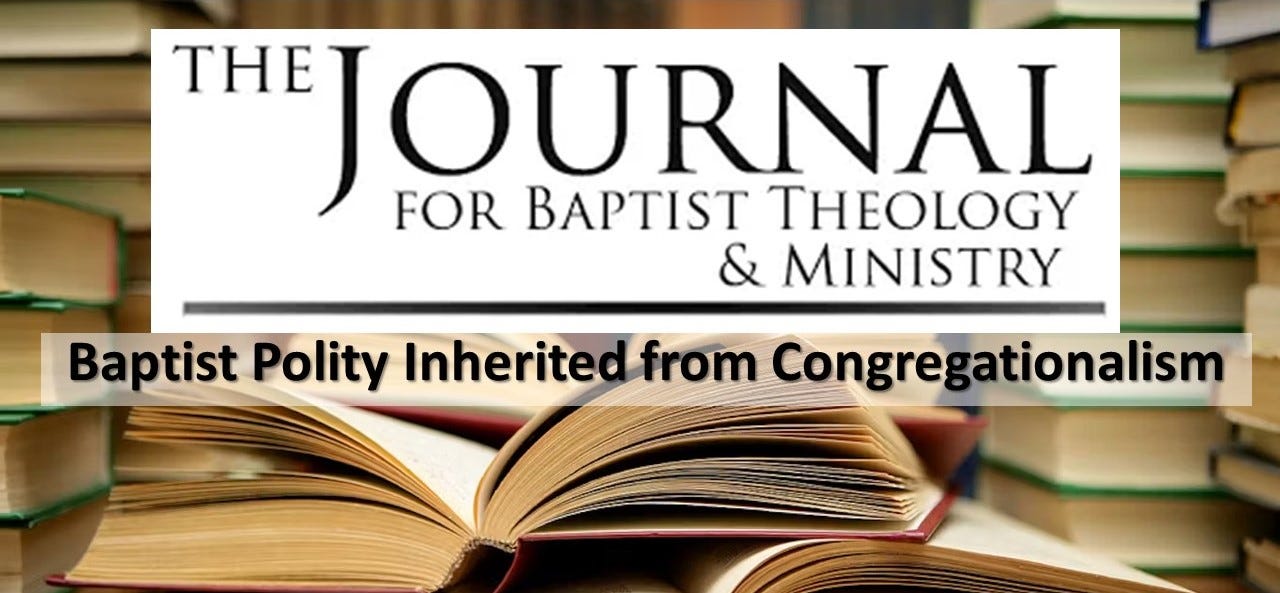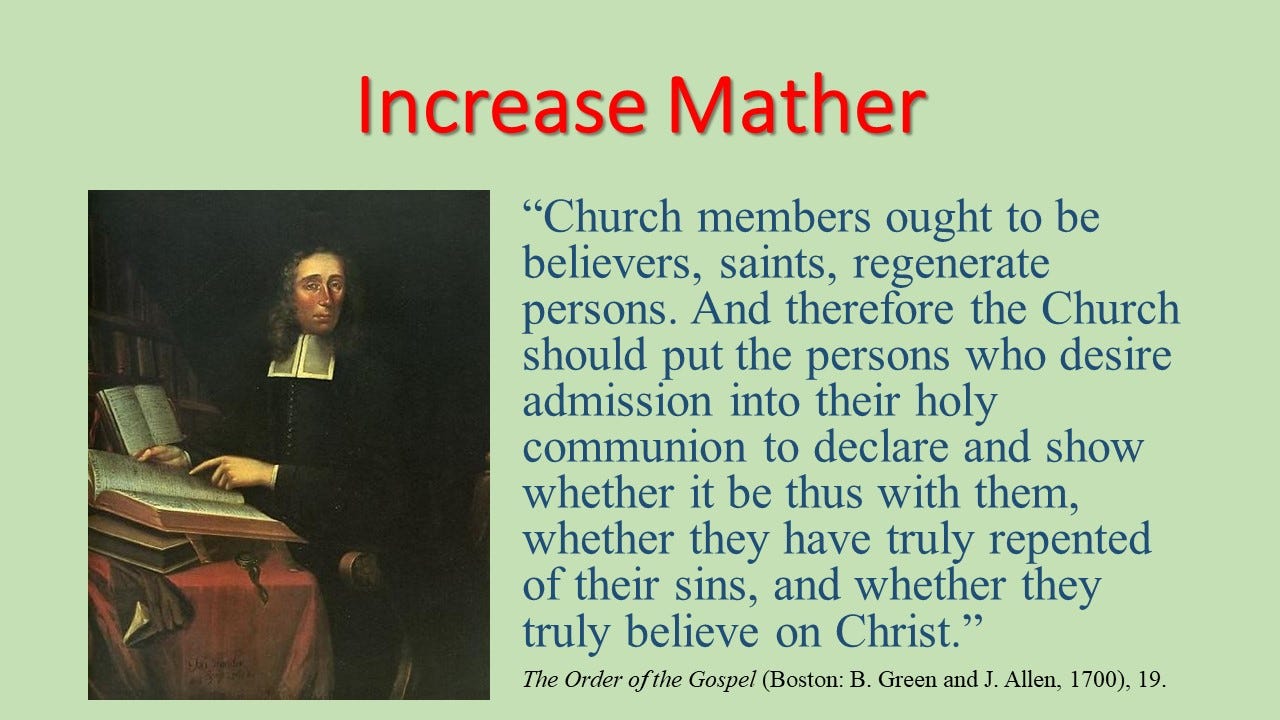This is an excerpt from an article published yesterday in The Journal of Baptist Theology and Ministry. If you want to read the entire article, click: Baptist Polity Inherited from Congregationalism (go to page 153).
The fact that Baptist polity – known as (small-c) congregationalism – is inherited from Congregationalism has been obscured by several bizarre historical anomalies. One is that New England Congregationalism seems to have disappeared into the thin air of history. Congregationalism has so diminished as a movement, we Baptists sometimes have to be reminded that the term applies to a denomination as well as a polity. They have no large, living institution faithfully preserving their theology and traditions today. (Harvard, sadly, doesn’t count.) The result is that we have few latter-day Congregationalists reminding Baptists of their family resemblance. Westminster Seminary, J. Gresham Machen, and R. C. Sproul remind Presbyterians of their heritage. Few have done so for orthodox Congregationalists and made the connection to modern Baptists. Baptists typically see Puritans as people they are contrasted to rather than favorably compared with. But Baptists inherited all the major – and many of the minor – features of their polity from Congregationalism (i.e. Puritanism).
Regenerate Church Membership
Baptists sometimes speak of regenerate church membership as if it were an exclusive doctrine of their own, or perhaps shared with the Anabaptists. . . . In 2013, Jonathan Leeman wrote, “The point of the doctrine [of regenerate church membership], historically at least, is to correct the error of [infant baptism].” Perhaps that was how the doctrine has been used in some Baptist polemics against infant baptism, but the statement that the doctrine historically arose for that purpose is false. As Mark Dever observed, regenerate church membership was the universal Christian doctrine until Reformed theology. It is also false because Puritan Congregationalists, while clinging to infant baptism, also held to regenerate church membership. Indeed, they pioneered many of the practices developed to safeguard it.
“The church which Christ in his Gospel hath instituted, and to which he hath committed the keys of his kingdom, the powers of binding and loosing, the table and seals of the Covenant, the Officers and Censures of his Church, the administration of all public Worship and Ordinances, is, Caetus fidelium, a Communion of Saints, a combination of faithful godly men, meeting for that end, by common and joint consent, into one congregation; which is commonly called a particular visible church.” — John Cotton (1585 –1652)
For more on regenerate church membership, click on the link above.
Testified Regenerate Membership
Geoffrey Nuttall (1911 –2007) wrote, “the demand that candidates for church membership shall not only possess a personal and conscious Christian experience but be both able and willing [to put] it in words . . . was . . . a sine qua non of any sharing in ‘church-state,’ as the Congregationalists men understood this.” That is, Congregationalists developed a tradition intent on guarding regenerate church membership.
For more on testified regenerate membership, click on the link above.
Letters of Dismission
There’s only two proper ways into membership in a Baptist church: either baptism or a letter of transfer (assuming the previous church still exists, is orthodox, or is willing to send a letter; if either of these cases don’t exist, then acceptance by statement of faith of a baptized person is acceptable.) Allowing members to join without a letter of dismission or commendation may undermine the discipline of a prior church, defeats the purpose of accountability church membership exists for, and may allow people who are “unsound and hypocrites inwardly” to be admitted into the church.
“When a member removes his residence nearer to another church of the same faith and order, he is bound in duty to procure a letter of dismission from the church to which he belongs.” — The Charlestown Association (1774)
For more on transferring church membership, click on the link above.
Church Covenanting
Mark Dever claims, “When persons joined a Baptist church, they subscribed to its covenant.” John Hammett notes that church covenants were “constitutive for Baptist churches in North America.” Deweese noted that original Baptists “viewed covenants, along with believer’s baptism and church discipline, as means of nurturing and safeguarding the New Testament emphasis on a regenerate church membership.”
“They are to voluntarily to give up themselves to the Lord and one another, . . . to walk together in all the ordinances of Christ, . . . in a mutual consent, covenant, or agreement” — William Bartlet
For more on church covenanting, click on the link above.
Priesthood of All Believers
While the priesthood of all believers doesn’t mean that all believers are equally gifted for leadership or ministry, it does mean, “the entire congregation should be involved in the governance of the church.” The Priesthood of All Believers places a responsibility on all Christians to maintain Christ’s authority in the church.
For more on the priesthood of all believers, click on the link above.
Local Church Autonomy
In Congregationalism, “the ultimate authority in the church lay with the members themselves.” “They claimed that the authority of Christ was exercised only through covenanted members gathered together as the church.” Therefore, the members decided who could join, whether and how to discipline errant members, and whether and how to recognize pastors. The membership, when following Jesus, reflect “binding and loosing” already done in heaven (Matthew 18:18.) Thus, holding the “keys,” every local church was held to be sufficient to govern itself. Members are the ultimate earthly authority of a congregational church.
“As consent is necessary to a person’s coming into the church, so none can go out of it without its consent.” — The Baptist Association in Charlestown
For more on local church autonomy, click on the link above.
Associationalism
Although Congregationalists held that their churches were autonomous, and “in all ecclesiastical matters equal,” they also believed their churches should formally associate.
“Although the churches of Jesus Christ are independent bodies . . . it is their duty to maintain friendly intercourse and fellowship with each other.” — J. L. Reynolds (1812-1877)
For more on associationalism, click on the link above.
The Ministry
“Congregationalists believe that the gifts of ministry and the orders and offices in the church are given not to individuals to exercise in the church but to the church to be exercised by individuals.”
For more on the ministry in congregationalism, click on the link above.
Conclusion
Baptists are a kind of congregationalist, the baptistic kind. As such, we’ve inherited nearly all of our traditional polity from them, before the nineteenth-century and the rise of sole-elder (the pastor) and deacon-led Baptist polity and, in the last generation, on the one-hand, the rise of elder-ruled baptistic churches – what I called “presbyterialism” elsewhere – and a pastor-as-CEO model, on the other. Amidst all the fog about Baptist origins and the confusion within modern ideas about polity, some Baptists, like those with 9Marks, have been trying to call us back to the wisdom of our Congregational founders. In order to understand congregationalism, Baptists need to understand Congregationalism.
John B. Carpenter, Ph.D., is pastor of Covenant Reformed Baptist Church, in Danville, VA. and the author of Seven Pillars of a Biblical Church (Wipf and Stock, 2022).










